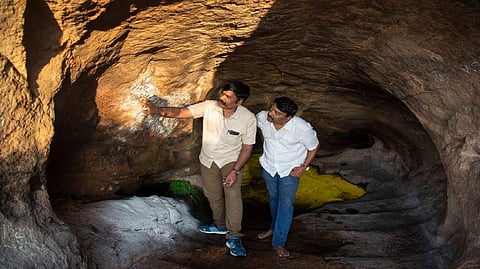

MADURAI: Ancient Tamil Brahmi inscription, which’s nearly 2200 years old, has been discovered in Thiruparankundram hillock cave, Madurai.
Thiruparankundram, a famous pilgrimage site in Madurai, is one among the six abodes of Lord Murugan, known as ‘Arupadaiveedu’ as a whole. The entire hillock is rich in archaeology and history, V. Balamurali, archaeologist in Madurai, who discovered the inscription, said on Wednesday.
There are many rock-cut temples of the early Pandyas on this hillock with two natural caves on the western slope of the hill opposite Thiruparankundram railway station. The cave above had several stone beds and three Tamil Brahmi inscriptions of the 1st century BC and 1st century AD. These are protected by the Archaeological Survey of India.
‘On the way to the cave above, there’s a small natural cave to its left. It has five stone beds inside. It is circular in shape and has a cut in front to prevent rainwater from entering’.
The Madurai based archaeologist Balamurali, who’s researching rock paintings, inscriptions and rock cut temples, found and studied the Tamil Brahmi inscription on the western side of the canopy of the cave.
Based on the information shared, Ramanathapuram Archeological Research Foundation president V Rajaguru and Pandya Country Historical Research Centre researcher Udhayakumar got access to the ancient cave site and read the inscription and re-studied it with the help of a senior archaeologist C Santhalingam.
They found that the inscription, which could be from the second century BC, had two lines. In the first line, except for a few letters like ‘tha’ and ‘ra’, the rest are all corrupted. In the second line also, some letters were lost and it’s difficult to decipher the inscription.
“The letters in the second line could be read as 'Yaara adhira eththa/////vathara'. Five lines are very clearly cut at a slight angle in the number 5 to represent the five stone beds cut in the cave,” the archaeologists pointed out.
The one, who set up these stone beds, could have been named as ''Yaara adhira”.
“The letters at the end could be read as (a)dhittanam. The letter 'a' is corrupted. Adhittanam means seat. It represents the seat of the stone beds into the cave. It’s noteworthy to point out that in the Tamil Brahmi inscription at Arittapatti and Thondur, three lines were carved to represent three stone beds,” the team of archaeologists, who wanted the Tamil Nadu Archaeology Department to take up further archaeological investigation here, said.
Visit news.dtnext.in to explore our interactive epaper!
Download the DT Next app for more exciting features!
Click here for iOS
Click here for Android